The utility said its board of directors made the decision at a meeting today not to restart Genkai 2, a 559 MWe pressurised water reactor which began commercial operation in March 1981. The reactor has been idle since being taken offline for periodic inspections in January 2011.
Under Japan's revised regulations, reactors have a nominal lifespan of 40 years. However, extensions can be granted once only and limited to a maximum of 20 years, contingent on exacting safety requirements.
Genkai 2 will reach the end of its 40-year operating period in March 2021. In order to extend its operating licence, Kyushu would need to submit an application by the end of March 2020. The utility said it has "considered submitting this application to enable future use of the plant's existing facilities".
However, Kyushu noted there is a lack of land on which to construct additional safety facilities in order for the unit to meet new regulatory standards. "The prospects for its output and remaining commercial operation period has led to the decision not to commence the approval procedure on the extension of the operating period for Genkai 2," the company announced today.
Kyushu said the unit has "played an important role in providing a stable power supply and in maintaining a low electricity rate, and thus a great contribution to the development of Kyushu's economy." The reactor, it said, has generated a total of some 120 TWh during its operation.
The company said it will now begin the procedure of decommissioning Genkai 2 in conjunction with unit 1, which has already been declared for decommissioning.
As a result of its decision to decommission Genkai 2, Kyushu has now decided to keep four of its seven units in operation. These are Genkai units 3 and 4 and Sendai units 1 and 2.
It said, "Nuclear energy is regarded as an important baseload power source in the government's Strategic Energy Plan and in view of such factors as energy security and combatting global warming, we aim to continue the generation at the four units while placing the highest priority on ensuring safety and security."
In mid-March 2015, the Ministry of Economy, Trade and Industry's Agency for Natural Resources and Energy revised the accounting provisions in the Electricity Business Act, whereby electric power companies can now calculate decommissioning costs in instalments of up to ten years, instead of one-time as previously. This enhanced cost recovery provision was to encourage the decommissioning of older and smaller units.
The formulation of that system prompted the announcement that five of Japan's smaller operable nuclear power reactors would be decommissioned. These included Kansai Electric Power Company's Mihama units 1 and 2; unit 1 of Japan Atomic Power Company's Tsuruga plant, as well as Kyushu's Genkai 1 and Chugoku Electric Power Company's Shimane 1.
In December 2017, Kansai announced that it would not seek permission to restart units 1 and 2 of its Ohi nuclear power plant in Japan's Fukui prefecture. The two 1175 MWe pressurised water reactors became the first reactors with capacities over 1000 MWe to be decommissioned following the accident at the Fukushima Daiichi plant in March 2011. The government also formally announced its decision in December 2017 to decommission the idled Monju prototype fast breeder reactor. In March 2018, Shikoku Electric Power Company announced that unit 2 of its Ikata plant in Ehime prefecture would be decommissioned.

.jpg)



_34792.jpg)
_16403_79272.jpg)



_76087_55556.jpg)



